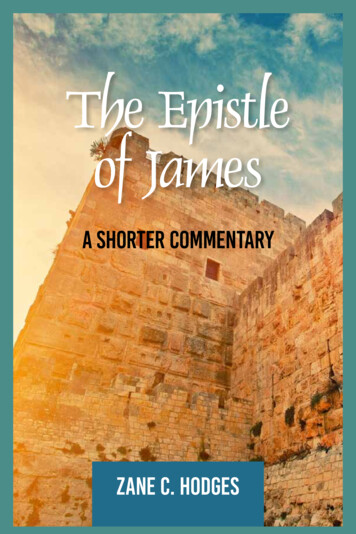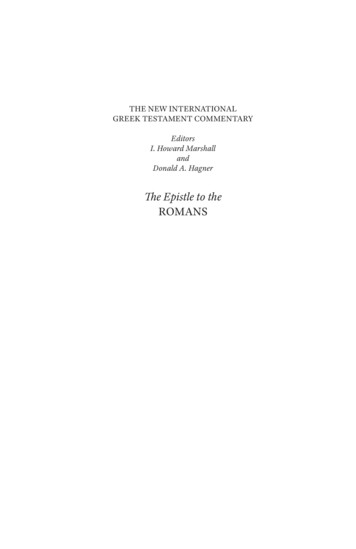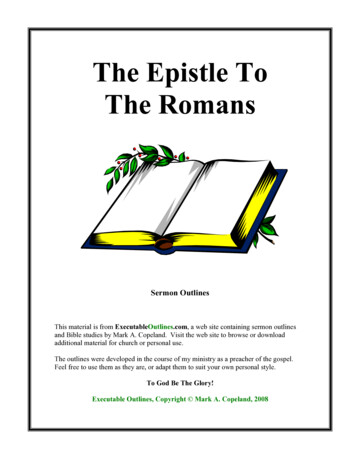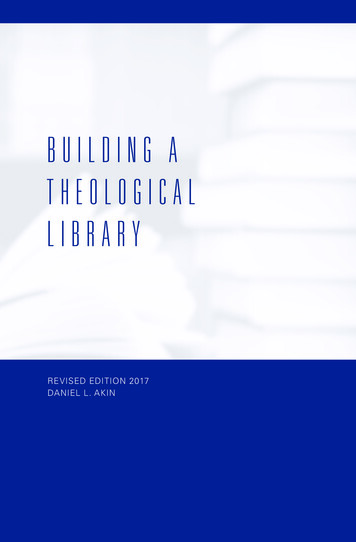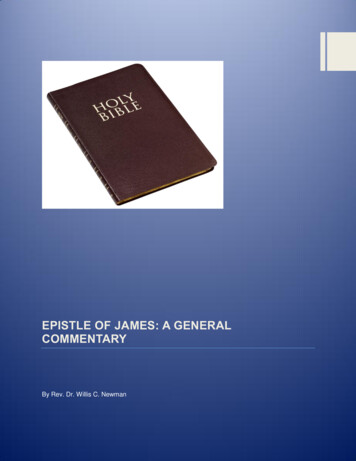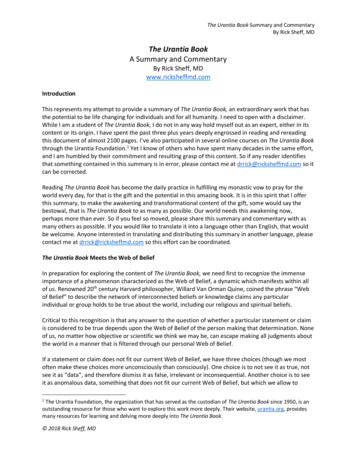
Transcription
CHRISTOCENTRIC COMMENTARY SERIESA Commentary on the Epistle to theHEBREWSkJESUSBetter Than EverythingJames A. Fowler
CHRISTOCENTRIC COMMENTARY SERIESA COMMENTARY ON THE EPISTLE TO THEHEBREWSkJESUS – Better Than EverythingJames A. FowlerciyPUBLISHINGP.O. BOX 1822FALLBROOK, CALIFORNIA 92088-1822
A COMMENTARY ON THE EPISTLE TO THEHEBREWSkJESUS – Better Than Everything Christocentric Commentary Series Copyright 2006 by James A. FowlerISBN-10 – 1-929541-07-4ISBN-13 – 978-1-929541-07-2All rights reserved. No part of this publication may be reproduced, storedin a retrieval system, or transmitted in any form or by any means (including photocopyings, recording, electronic transmission) without the priorwritten permission of the author, except for brief quotations embodied incritical articles or book reviews. For information contact the author atC.I.Y. Publishing.Published by C.I.Y. PUBLISHINGP.O. BOX 1822FALLBROOK, CALIFORNIA 92088-1822Printed in the United States of AmericaScriptural quotations are primarily original translations from the Greektext of the New Testament, but otherwise from the New AmericanStandard Bible, copyrights 1960, 1962, 1963, 1968, 1971, 1972, 1973,1975, 1977, 1995 by the Lockman Foundation, LaHabra, California.
CHRISTOCENTRIC COMMENTARY SERIESCognizant that there are a plethora of New TestamentCommentary series available on the market, the question mightlegitimately be asked, “Why another series of New Testamentcommentaries?” Although many capable commentators withvarying theological perspectives have exegeted the text of theNew Testament over the years, seldom do they bring withthem into their studies a Christocentric understanding that theChristian gospel is solely comprised and singularly centered inthe Person of the risen and living Lord Jesus Christ. TheChristocentric Commentary Series will exegete and commenton the text of the New Testament from the perspective that thetotality of what Jesus came to bring to the world of mankind isHimself – nothing more, nothing less. Having historically diedon the cross and risen from the dead, He is not confined to theparameters of the “Historical Jesus,” but as the Spirit of ChristHe continues to live as He spiritually indwells those who arereceptive to Him by faith. This recognition of the contemporary experiential dynamic of Christ’s life in the Christian willform the distinctive of the Christocentric Commentary Series,bearing out Paul’s Christ-centered declaration, “I have beencrucified with Christ; it is no longer I who live, but Christlives in me; and the life I now live in the flesh I live by faithin the Son of God, who loved me and gave Himself up for me”(Gal. 2:20).
All legitimate exegesis of the scriptures must pay closeattention to the context in which the texts were originally written. The historical context of a text’s sitz im leben, the “settingin life” of the author and recipients, is particularly important,for otherwise the interpretation will simply read into the textthe presuppositions of the commentator and become eisegesisinstead of exegesis. The CCS will carefully consider the historical context as well as the textual context of the scriptures.Whereas the CCS is not intended to be a devotional commentary series or a detailed technical commentary citing allcontemporary scholarship, our intent is to steer a middlecourse that maintains non-technical explanation that is academically viable. Although reference will be made to wordsfrom the Hebrew and Greek languages, those words will beconverted to Roman lettering, allowing those who do not knowthe original languages to pronounce them. Citations, quotations, and endnotes will be kept to a minimum.A diversity of interpretive formats will be utilized in theCCS. Some volumes will employ a verse-by-verse exegeticalformat (cf. Hebrews and Galatians), whereas others will provide comment on contextual passages (cf. The Four Gospelsand Revelation). Regardless of the interpretive format, theCCS will render a “literal interpretation” of the scripture text,that is, in accord with the intended literary genre of the author.As most biblical commentaries are utilized by pastors andteachers, or studious Christians seeking to understand thescriptures in depth in order to share with others, we join theApostle Paul in the desire to “entrust these to faithful men(and women) who will be able to teach others also” (II Tim.2:2). In so doing, may you “do all to the glory of God” (I Cor.10:31).
TABLE OF CONTENTSIntroduction . . . . . . . . . . . . . . . . . . . . . . . . . . . . . . . . 1Hebrews 1:1 – 2:4 . . . . . . . . . . . . . . . . . . . . . . . . . . 17Hebrews 2:5-18 . . . . . . . . . . . . . . . . . . . . . . . . . . . . 49Hebrews 3:1-19 . . . . . . . . . . . . . . . . . . . . . . . . . . . . 79Hebrews 4:1-13 . . . . . . . . . . . . . . . . . . . . . . . . . . . 107Hebrews 4:14 – 5:10 . . . . . . . . . . . . . . . . . . . . . . . 135Hebrews 5:11 – 6:20 . . . . . . . . . . . . . . . . . . . . . . . 161Hebrews 7:1-28 . . . . . . . . . . . . . . . . . . . . . . . . . . . 201Hebrews 8:1-13 . . . . . . . . . . . . . . . . . . . . . . . . . . . 227Hebrews 9:1 – 10:18 . . . . . . . . . . . . . . . . . . . . . . . 255Hebrews 10:19-39 . . . . . . . . . . . . . . . . . . . . . . . . . 303Hebrews 11:1-40 . . . . . . . . . . . . . . . . . . . . . . . . . . 327Hebrews 12:1-13 . . . . . . . . . . . . . . . . . . . . . . . . . . 371Hebrews 12:14-29 . . . . . . . . . . . . . . . . . . . . . . . . . 401Hebrews 13:1-25 . . . . . . . . . . . . . . . . . . . . . . . . . . 431
x.
IntroductionJESUSBetter Than EverythingAn Introduction to the Epistleto the HebrewsThe Epistle to the Hebrews has suffered from anonymity.There is anonymity of both author and recipients because thesedetails are not included in the text of the letter. Such anonymity makes the document suspect in the minds of some for itprovides no specificity of its intended meaning within a givencontext. The anonymity of writer and reader allows the epistleto be abstracted and generalized without a specific sitz imleben (setting in life) to provide historical context and a basisfor specific amplification and application of the meaning ofthe words. Anonymous text allows for a dilution of meaning ininterpretation of the text, or allows an expositor to run rampantwith personal presuppositions imposed upon or applied to thetext. In other words, anonymity can diminish exegesis (interpretive meaning drawn out of the text) and/or facilitate eisegesis (interpretive meaning read into the text). In either case,whether subtractive or additive, such interpretation cannot anddoes not take into account the full intent of the original authorto his recipients, and thus diminishes the value and meaning ofthe text for subsequent generations of readers.This has certainly been the case in the interpretation of theEpistle to the Hebrews. The letter has suffered from neglectand misuse. The regrettable consequence of the anonymousauthorship of this literature has been the reluctance of someChristians to accept it as fully authentic and authoritative.Even in the early church it was little used and cited. Hebrews1
Introductionhas suffered from a subtle skepticism throughout Christian history because of its unknown authorship, and contemporaryinterpretation continues to neglect this important portion ofinspired scripture. But perhaps of greater consequence is thefact that the Church through the ages has therefore sufferedfrom the lack of understanding of the unique message of thisletter in its assertion of the radical supremacy of the Christiangospel over Judaic religion, and religion in general.The Epistle to the Hebrews is not the only document ofantiquity that is devoid of the details of origin and destination.Within the New Testament literature itself there are otherexamples of literature without statement of authorship or destination. John's epistles, for example, do not contain his name orany designation of his readers, but these have been reconstructed with what evidence is available (particularly in thecase of First Epistle of John) to provide a meaningful historical context for interpretation. The same can be accomplishedfor the Epistle to the Hebrews, as we will set about to do.The task of a biblical expositor is to consider the evidenceavailable concerning the historical context of a document,draw a conclusion based on that evidence, and interpret thetext accordingly. Biblical scholarship, with its ever-skepticalapproach, has been very cowardly in drawing conclusionsabout the authorship of Hebrews, thus assuring that the textcan have only nebulous interpretive meaning. What, then, isthe evidence for authorship, destination and dating of this epistle, in order to give it specific historical context? What is themost legitimate conclusion that can be drawn based on thatevidence?AuthorshipThe primary objections to Pauline authorship have traditionally been explained as: (1) the absence of Paul's name inthe epistle, (2) the apparent second-hand knowledge referred to2
Introductionin 2:3, and (3) the style, grammar and vocabulary of the epistlewhich seems to differ from other Pauline writings.The absence of Paul's name or signature was explained asearly as A.D. 200 in the Hypotypos of Clement of Alexandria(c. 155-215). Though that eight volume outline of Christianthought has not been preserved, a portion of that documentwas quoted by Eusebius in his Ecclesiastical History:He (Clement of Alexandria) says that the Epistle to the Hebrews is thework of Paul, and that it was written to the Hebrews in the Hebrewlanguage; but that Luke translated it carefully and published it for theGreeks, and hence the same style of expression is found in this epistleand in the Acts. But he says that the words, “Paul the Apostle”, wereprobably not prefixed, because, in sending it to the Hebrews, who wereprejudiced and suspicious of him, he wisely did not wish to repel themat the very beginning by giving his name. .Paul, as sent to theGentiles, on account of his modesty did not subscribe himself an apostle of the Hebrews, through respect for the Lord, and because being aherald and apostle of the Gentiles he wrote to the Hebrews out of hissuperabundance.1The reason for the absence of Paul's name is herebyexplained early in church history as a sensitivity of the"Apostle to the Gentiles" in writing to Hebrew peoples, whowere his kinsmen. The absence of his name does not excludePaul from authorship any more than the absence of John'sname excludes his authorship of the epistles attributed to him.The contested statement in Hebrews 2:3, "After it (theword of salvation) was at first spoken through the Lord, it wasconfirmed to us by those who heard," seems to evidence a second-hand knowledge of the gospel, and Paul certainly arguesvehemently for the right of apostleship through a first-handknowledge of Jesus Christ in Galatians 1:11–2:10. But thewords can just as accurately be interpreted by explaining thatPaul was admitting that he was not one of the original twelvedisciples who traveled with the historical Jesus, and thereforewas not privileged to directly hear the words that Jesus spoke3
Introductionin that context. This does not in any way diminish his apostleship that he argued for in Galatians, such argument for hisapostleship to the Gentiles obviously muted in this correspondence to Jewish Christians.The argument of differing style, grammar and vocabularyis not all that conclusive either, especially since this epistlewas being written to any entirely different audience and withan entirely different purpose than any of Paul's other epistles.Many of the vocabulary differences, where Paul employswords not used in other writings (hapax logomena), are in thecontext of his contrasting Jesus with Jewish history and theology, of which he was obviously quite knowledgeable andwould not have been so apt to use in writing to Gentile congregations. The stylistic differences of the Greek text wereexplained by Clement of Alexandria (see above) as due toLuke's translation from Hebrew to Greek.Having considered the objections to Pauline authorship, itis incumbent upon us to now present the evidence that existsthat points to Paul as the most likely author of this letter.The papyrus fragment identified as P46 is the oldest extantmanuscript of the Pauline epistles. This Greek manuscriptfrom Alexandria in Egypt is dated around A.D. 200, and thereare no earlier available manuscripts of Paul's epistles. Byacceptable criteria of textual criticism, the oldest manuscripts,i.e., those closest to the date of the original writing, must begiven greatest import or weight in textual considerations. SinceP46, the earliest manuscript containing the Pauline corpus ofliterature, includes the Epistle to the Hebrews immediately following Paul's Epistle to the Romans and attributes authorshipof the epistle to the Hebrews to Paul, this ascription must begranted a predominating weight of evidence in the critical consideration of authorship.We have already noted that the eight volume Hypotypos ofClement of Alexandria, written c. A.D. 200, clearly indicatedthat Paul was the author of the Epistle to the Hebrews, giving4
Introductionexplanation of the absence of his name in the epistle andexplanation of the variation in grammatical style of the Greektext (see quotation from Eusebius above).Origen (185-253), in his Commentary on the Gospel ofJohn, wrote that "the Apostle Paul says in the Epistle to theHebrews: 'At the end of the days He spoke to us in His Son'.”(Heb. 1:2).2 Origen clearly attributes Pauline authorship to theEpistle to the Hebrews, from which he quotes.The early Alexandrian scholars of the Eastern Church consistently regarded Paul as the author of this epistle. The scholars of the Western Church in Rome were more skeptical ofPauline authorship until Jerome (c. 340-420) and Augustine(396-430) supported the thesis of Paul's authorship. From theSixth Synod of Carthage (419) until modern times, the RomanCatholic Church affirmed Pauline authorship of the Epistle ofthe Hebrews. The Protestant reformers, on the other hand,revived the questioning of Paul's authorship, with MartinLuther the first to propose Apollos as the author and JohnCalvin speculating that Clement of Rome or Luke may havebeen the author. Scholastic speculations of authorship of thisepistle have abounded since the Reformation, often with arrogant unwillingness to accept early tradition or to counter prevailing skepticism of scholarship.As additional evidence it should be noted that the authormentions Timothy (13:23), who was Paul's closest colleague inministry, mentioned often in other Pauline epistles (Rom.16:21; II Cor. 1:1; Phil. 1:1; 2;19; Col. 1:1; I Thess. 1:1; 3:2,6;Philemon 1:1). The author appears to have previously visitedthe group of people to whom he was writing, and hoped torevisit them (13:19,23), consistent with the fact that Paul hadvisited the church in Jerusalem on several occasions (Acts21:11-31; Rom. 15:25; Gal. 1:18). The mention of the "saintsof Italy" (13:24) would be consistent with Paul's imprisonmentin Rome, and his desire to send greetings on behalf of the5
IntroductionItalian Christians to the Jewish-Christian recipients of this letter.The evidence is certainly not sufficient to dismiss or denyPaul as the most likely author of this epistle to the Hebrews. Infact, we must be honest enough to admit that the preponderance of the evidence leads to Pauline authorship. All other proposed authors of this epistle (Silas, Philip, Mark, Priscilla, etc.)are merely speculative assignments, "shots in the dark" to suggest another name other than Paul. The name of Apollos wasnot even suggested until the 16th century by Martin Luther.There is no way to compare the literary criteria of grammar,vocabulary and style with other writings of these speculativelyproposed authors for many of them have no other literature tocompare with. What a convenient way to preclude Paulineauthorship and preempt having to deal with the grammaticalissues by assigning authorship to unpublished persons.Though one must "swim against the tide" of several centuries of skeptical academic scholarship in the textual criticismof Protestant biblical studies, the evidence is quite sufficient toassert that the Apostle Paul was the most likely author of thisEpistle to the Hebrews.RecipientsThe text does not indicate who the first readers were, againleaving us with an anonymity of original recipients. So, whatinternal and external evidence can be presented to make anassignment of destination?Based upon the abundance of references to Jewish religionand the old covenant, particularly the Levitical priesthood andtemple practices, this document has been referred to as "theEpistle to the Hebrews," at least since the latter part of the second century AD. It is reasonable to assume that the originalreaders were Christians from a Jewish background, eventhough the quotations from the Old Testament seem to be from6
Introductionthe Greek translation of the Septuagint (LXX), which would beconsistent with Paul's bilingual knowledge of the OldTestament and his frequent utilization of the LXX amongGentiles.It appears that the author was addressing a particular community of Christians with whom he was personally acquainted.He was aware of their having endured persecution (10:32,33;12:4), as well as their present situation (5:12; 6:9; 13:17), andintended to revisit them (13:19,23). The author and the readerswere mutually acquainted with Timothy (13:23).The mention of "Italy" (13:24) in the closing comments ofthe epistle has caused some to conclude that the recipientswere Jewish Christians residing in Rome, who were beinggreeted by fellow Italians living in the location from whencethis epistle was written. That same reference can be interpretedto mean that the location of origination was Italy, however,and that the author is sending greetings to the readers from theItalian Christians where he is located. Although other destinations such as Alexandria, Caeserea, Ephesus, Corinth, andAntioch have been suggested, the most likely location of theresidence of the original readers is Jerusalem.Who else would have had such attachment to Jewish history and theology, such close ties with temple worship and itssacrifices, such pressure to relapse to Judaic religion, than theHebrew saints in Jerusalem? Consider also that in subsequentChristian history no church claimed that this letter had beenwritten to them, a practice of all the other churches whosought to make a "claim to fame" as the recipients of an apostolic letter from Paul. The church at Rome did not claim thisletter. The churches at Alexandria, Ephesus, Corinth orAntioch did not claim this letter. No church claimed to be therecipients of this letter in the history of the early church. Theexplanation for this phenomenon is simple: within a few yearsafter this epistle was written the church at Jerusalem ceased toexist. Jerusalem was destroyed in A.D. 70 Palestine was devas7
Introductiontated and its inhabitants decimated. There was no church inJerusalem to lay claim to being the recipients of this epistleafter A.D. 70 This serves as an important historical evidence tothe Jerusalem church having been the likely recipients of thisletter.It is most reasonable to assume that Paul was imprisonedin Rome in the mid-60s of the first century (as we know fromLuke's account in the Acts of the Apostles 28:16-31), and hehad a good social and spiritual perspective of what was goingon in the Roman persecutions of Christians under EmperorNero (who died in A.D. 68), as well as the Roman attitudestoward the Palestinian Jews. He also knew the attitudes of thePalestinian Jews with their intense nationalist patriotism, theirreligious absolutism, their racist superiority, and he could foresee that a violent war was about to erupt in Palestine betweenthe Romans and the Jews.The Christian Jews in Palestine had lost their leaders(13:7), and Paul, though he knew he was the Apostle to theGentiles (Acts 9:15; Rom. 1:5; Gal. 1:16; 2:7), never lost hisheart for his Jewish kinsmen (Rom. 9:3). It is likely that hedecided to write this letter to encourage (13:22) the JewishChristians in Jerusalem to be confident in their endurance(10:35,36) by emphasizing the superiority of Jesus over allreligion. The Palestinian Christians were being pressured torevert to Judaism, to join the patriotic cause of militaristicdefense against the Roman empire. Christianity did not seemto be going anywhere except among the Gentiles, and eventhen Paul was on death-row in Rome. Some of the Christianswere not even assembling together anymore (10:25), werebecoming casual about sin (10:26; 12:10-16), and were in danger of apostasizing (6:4-6; 10:26-31).Paul writes to encourage these Palestinian Christians not totake the easy way out and revert to religion again, in particularJudaism, with its religious practices and nationalistic patriotism. He explained that the old covenant of God's working with8
Introductionand through the Jews, was obsolete and would soon disappearin destruction (8:13) – as it soon did in A.D. 70 The oldcovenant was only intended to pre-figure and set-up the newcovenant of all that God intended to do in His Son, JesusChrist. Jesus is the fulfillment of all the old covenant picturesand types, the fulfillment of all God's intents and promises (IICor. 1:20) for His people. "Don't go back to religion," Paul issaying. "Go outside the camp" (13:13), repudiate Judaism, perhaps even consider leaving Jerusalem and Palestine (as manyof them did, and survived the Roman slaughter of 70 A.D.). Toreject Christ and go back to Judaic religion (any religion) isfatal and final, Paul indicates (10:29-31). Paul was telling thePalestinian Christians that there was a polarity of either/or,either Christ or Judaism, but you cannot have both. Like oiland water, Christianity and religion do not mix!J. Barmby explains thatwhen the Epistle to the Hebrews was written, the time had come for acomplete and final severance from the ancient order. For now the predicted judgment was impending on Jerusalem, the temple was about tobe destroyed forever, the whole sacrificial system connected therewithto cease, and the nation to be scattered through the world without ahome in Palestine. Full time was it now for Christ's followers fully toperceive that from the old dispensation, never more than provisional,the glory was passed away; to come entirely out of the once holy butnow doomed city; to lean no longer on the tottering fabric of the temple, lest their very faith should be shattered in its downfall.3If, as the evidence suggests, Paul wrote this epistle to thechurch in Jerusalem which was undergoing persecution (notonly by the Romans, but even more by the Palestinian Jews cf. 10:32-36), then this epistle was one of the last, if not thelast, that Paul wrote. Why is this important? Because if theEpistle to the Galatians was the first of Paul's extant epistles,and the Epistle to the Hebrews was the last, then we canobserve the total consistency of Paul's thinking throughout hisministry. Galatians and Hebrews are two of the clearest New9
IntroductionTestament epistles exposing the radical uniqueness ofChristianity as set against the old covenant and Judaic religion.All of Paul's other writings must then be interpreted in thecontext of Galatians and Hebrews, as they form the alpha andomega of the Pauline corpus, serving as the "bookends" ofPauline theology.Date of WritingThere is also no direct indication of the date of writing inthe text of this epistle. Most scholars have concluded that itwas written prior to the fall of Jerusalem in A.D. 70 sincethere is no reference to that catastrophic historical event, andone would certainly expect such had it been written toChristian readers of Jewish background after that event. Thewriter's repeated references to Jewish rituals using presenttense verbs (7:8; 9:6-13; 13:10,11) also seems to indicate adate when such practices were still being performed in thetemple at Jerusalem prior to its destruction. The only other referent point for dating this document is that Clement of Romewas apparently acquainted with this epistle by approximatelyA.D. 95.It is quite likely that Emperor Nero's "urban renewal project" had just occurred in Rome, when in A.D. 64 Nero hadapparently arranged to burn a large section of Rome in order toclear the way for his building campaign which would memorialize him in its lasting grandeur. "Nero fiddled while Romeburned" was the scuttlebutt that prevailed at the time, and thephrase remains as a lasting indictment to that imperial crime.The Christians, regarded as but a sect of the Jews at the time,became Nero's scapegoat of blame for setting the fire, ignitingan incendiary wave of suspicion and persecution against theChristians, as well as the Jews.Paul, under house arrest in Rome, might well haveobserved the glow of the flames and smelled the smoke from10
Introductionthe fire. Hearing that the Christians had been blamed for setting the fire, Paul may have "seen the handwriting on thewall,” so to speak, and realized that the days ahead would bedifficult times for Christians and Jews. Paul was also wellaware of the growing sentiment of resentment against Rome inPalestine, with the feverish swell of nationalistic patriotismbeing incited by the Zealot party within Judaism, advocatingtheir alleged God-given right as the "chosen people" of God tooperate as a sovereign nation in the line of David within thePalestinian land that they regarded as their "promised land."But Paul may have had a much better perspective of the mightand power of the Roman army than the Palestinian peopleshad in their blind fervor for self-rule. He may have had graveconcerns of the outcome if the Roman military were to moveinto Palestine to put down an insurrection of revolt againstRome by the Jewish nationalists. Aware of attitudes both inRome and Palestine, Paul may have decided that this was atimely opportunity to encourage his Christian brothers inJerusalem by writing an epistle to the Church there, encouraging them to remain faithful to Jesus Christ and not to succumbto the political and religious influences that were beingbrought to bear upon them at that time.The best conclusion, based on the evidence, seems to indicate that this letter was written by Paul from Rome to theHebrew Christians in Jerusalem in the middle 60s of the firstcentury, perhaps in A.D. 64 or 65 just prior to Paul's likelyexecution at the hands of the Romans.Interpretive ConsiderationsBe forewarned that the Epistle to the Hebrews containswhat is perhaps the most radical message in the NewTestament. It may upset the applecart of your religious understanding. No other book in the New Testament so categoricallyasserts that God's arrangement with men in the Old Testament11
Introductionis no longer valid, making that point by declaring that Jesus isbetter than every feature of the old covenant. To drive thepoint home the readers are warned that if they revert to theJudaic religious practices of their past, having participated inthe new covenant realities of Jesus Christ, they will forfeit allopportunity to participate in the eternal realities of Jesus Christagain.With at least eighty-six direct references to the OldTestament within this letter, and with constant attention drawnto the Jewish people and their religion, it is important to consider the correlation of this document to the Old Testament.Some have indicated that a thorough understanding of the OldTestament is essential to understanding the Epistle to theHebrews. Though it is true that an understanding of the historical background and ritualistic practices of the old covenantand the Hebrew peoples provides a valuable context for interpreting this document, it is perhaps even more important torealize that a thorough understanding of the Epistle to theHebrews is essential to a proper understanding of the OldTestament from a Christian perspective. If the "Old Testamentis the New Testament concealed, and the New Testament is theOld Testament revealed," as has often been explained as thebasis for Christian hermeneutics, then the revealing of thegospel, especially in the book of Hebrews, should serve as thestarting-point to consider how the gospel was concealed in theclues of the prefiguring of the Old Testament. The failure tointerpret the Old Testament from this perspective has led tomuch confusion and misemphasis in Christian teaching, allowing the Old Testament to serve as the priority literature even inthe lives of new covenant Christians. When this happensChristianity is perverted into religious forms of ChristianizedJudaism, which is the very thing that this epistle warns againstand condemns. The Epistle to the Hebrews is the best antidoteto such religious perversion, serving as the necessary commentary on the Old Testament, and interpreting the history, wor12
Introductionship and prophecy of the Old Testament as it points in itsentirety to Jesus Christ.Clyde F. Whitehead explains,The Hebrews epistle deals with most of the important things that wereassociated with the old dispensation. The writer's objective is to showthat the Mosaic law has been replaced by something that is far 'better.'4J. Barmby, writing in the Pulpit Commentary, comments,its main purport is to show, from the Old Testament Scriptures themselves, that the Mosaic dispensation was from the first only preparatory for and prophetic of a higher one to come which was entirely tosupersede it, and that Christ had come as the one only true High Priestfor all mankind, the true fulfilment of all ancient ritual and prophecy,the satisfaction of all human needs, to renounce whom would be torenounce salvation.5The Epistle to the Hebrews is pivotal
CHRISTOCENTRIC COMMENTARY SERIES A COMMENTARY ON THE EPISTLE TO THE HEBREWS JESUS– Better Than Everything James A. Fowler PUBLI
